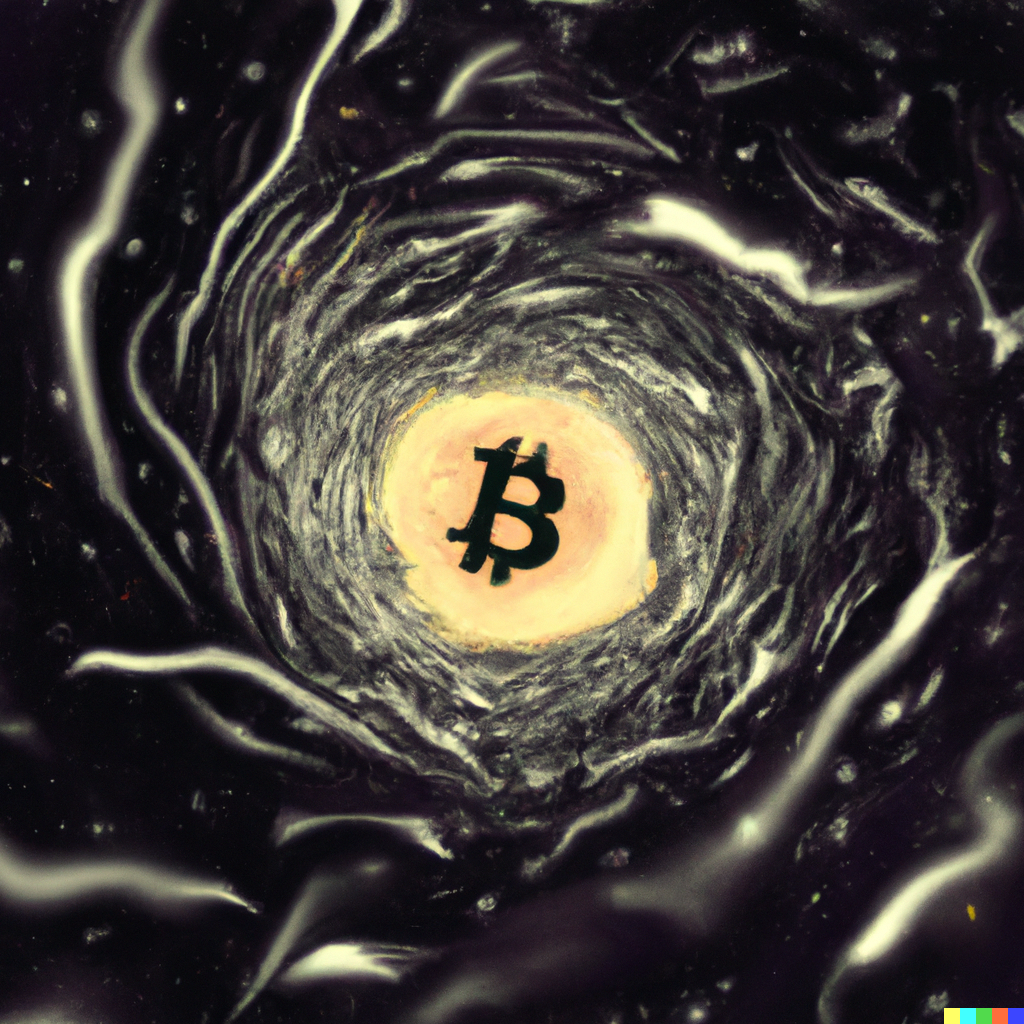Equity venture capital for companies building on Bitcoin
#6 The Bitcoin Singularity
Singularity; a point at which a function takes an infinite value, especially in space–time when matter is infinitely dense, such as at the centre of a black hole

TL;DR
- A set-in-code fixed bitcoin supply and known issuance schedule is the core of why bitcoin has value
- It is the only asset in the history of human civilisation where supply is completely unresponsive to increases in demand
- Against all other assets, bitcoin is consuming value like a black hole (or singularity) consumes matter
- In a digital world, where the marginal cost of production of everything is falling to 0, bitcoin is unique
- It is a digital asset for which the marginal cost of production can never be 0, because energy must be expended and energy is never free
- In other words, bitcoin is a non-physical and entirely digital asset that cannot be copied and pasted. It is the invention of digital scarcity
- Bitcoin introduces the laws of physics to the digital world. As such, AI is perfectly complementary to bitcoin because even an AI must marshal physical resources
∞/21m
There will only ever be 21m bitcoin. We know as much because it’s in the code and that code is distributed and adhered to by thousands of individuals running ‘nodes’ around the planet. This uncompromisable supply cap is the root of why bitcoin has value. The issuance schedule for new bitcoin production is also set in code. Roughly every 10 minutes, bitcoin miners utilising energy find a new block, group transactions into that block and receive a predetermined amount of bitcoin as a reward. If the mining power going into the bitcoin network increases, the ‘difficulty adjustment’ ensures that it is proportionately harder to find the next block and so the block time remains constant. Bitcoin is therefore the only asset in human civilisation that is unresponsive to an increase in demand.
The same is not true for gold or equities or real estate or tulips or indeed anything else. When demand increases, supply increases as the incentive to produce more of it also increases. More gold is mined, Apple issues more stock, developers build more homes, gardeners plant more tulips. But when demand for bitcoin increases, supply cannot adjust and so price must. Price is the pressure valve.
Simple supply and demand dynamics are quite capable of explaining the rapid and inevitable price appreciation of bitcoin as an asset, but bitcoin is more compelling yet as a monetary network. A core contention of ours at Timechain is that the design space for money is limited and bitcoin sits at the apex of that design space. Bitcoin is far more portable, divisible, durable, verifiable, scarce, recognisable and censorship resistant than any ‘competitor’ and as an open, dynamic network can be upgraded when necessary. Our expectation for this decade is that bitcoin becomes more private, for example. Any rival money could outcompete on one of those dimensions, but not all of them. An explanation of why would discuss the energy footprint of bitcoin, the game theory of network participants, its initial distribution method by a pseudonymous founder and the network effect of money itself. The latter is quite straightforward; the job of money is to be the most liquid good and so having multiple monies introduces unnecessary economic friction.
For now, though, we can posit that bitcoin is money perfected. It’s logical to assume there will be consequences for all that is financialised. As previous newsletters have hinted at, we believe that consequence is that every other asset is being demonetised. The market has been searching for perfect money but, given it did not exist until recently, the store of value function (amongst others) of money had to be deputised to other assets. This is the ‘monetary premium’ component of an asset’s value that we have mentioned before. In short, there are two components to the value of any asset: the utility value and the monetary premium. The utility value is the value derived from the usage of the asset. For example, a home has value for those who live in it. The monetary premium of the home is derived from the speculative value market participants place on it because they think it will be a good store of value. Given a fixed-supply monetary asset now exists, there is no need for other assets to imitate a store of value function. As such, an inflated monetary premium is not sustainable in this new economic paradigm.
A somewhat tedious criticism of late has been that bitcoin trades like a risk-on asset with high correlation to equities and particularly tech stocks. This is true, it has. But it ignores a more significant truth – the bitcoin price is increasingly set at the margins by the un-initiated. The vast majority of bitcoin has not moved for quite some time. And we will soon see the power of a fixed-supply perfected monetary asset.
AS OF APRIL 30TH 2023, AN ALL-TIME HIGH OF 67% OF BITCOIN HAD NOT MOVED FOR OVER A YEAR
When the correlation between bitcoin and risk-on assets breaks, we will have reached the bitcoin singularity. When supply – due to unprecedented inactivity – completely decouples from demand, the price will once more go parabolic. Bitcoin, the black hole at the centre of our economic universe, sucking in the monetary premium of all assets around it as it continues an inevitable ascent to infinity.
To summarise;
- All other assets have a limitless supply, whereas bitcoin supply is permanently fixed at 21m
- Bitcoin is the pinnacle of monetary design
- Money is the ultimate network effect as its purpose is to be the most liquid good. Multiple currencies must be enforced through coercion. Why would anyone freely choose to hold the second-best money?
- In bitcoin terms, the monetary premium of all assets will trend to 0 as bitcoin extracts the monetary premium associated with the store of value function
Or, put otherwise;
∞/21M
‘Everything there is and everything there ever will be, divided by 21m’ Knut Svanholm
Digital scarcity in a digital world
Scarcity is valuable. But in a digital world of seeming unlimited abundance, where the cost of production is 0 across an increasing swathe of the economy, is scarcity a meaningful concept? And more speculatively, is any of the above at all relevant in a world where superintelligence is a genuine possibility?
To start, it’s worth recognising that productivity breakthroughs are inherently disinflationary. Digitisation has already collapsed the marginal production costs of many goods to 0. Think music, film and written content. You can copy and paste anything in your computer and send it to anyone or indeed everyone, for free. AI exacerbates this disinflationary trend. The cost of a well-written article is now 0 (this blockbuster aside), as is the cost of computer-generated images depicting any imaginable scenario. Interpreting tax law, finding errors in computer code and personalised language tuition are more examples of formerly expensive activities falling to 0 cost. The point is that technology collapses costs. But collapsing costs and the implied effect on prices does not mix well with an inflationary economic system. A civilisation where total global debt is 4x of GDP— >$400 trillion and increasing fast—cannot handle deflation. Prices must continue to rise or else we face a crushing debt collapse. So, to offset the exponential disinflationary effects of advanced technologies, more ‘money’ (political currency units of your local jurisdiction) than ever before will have to be printed.
But bitcoin cannot be printed, nor can the supply cap or the issuance schedule be altered. And in the digital realm, where technologies like AI are steadily increasing the ease of production of everything, bitcoin stands alone. Bitcoin is a scarce asset in cyberspace! Prior to bitcoin, digital scarcity was an oxymoron, but here we have a digital asset that cannot be copied and pasted. An asset that is native to the internet and our digital existence, that possesses all the benefits of being digital but is rooted in the physical world to ensure it cannot be replicated or diluted.
To find new bitcoin, work must be done, and energy must be expended. Energy is the currency of the universe and energy expenditure cannot be cheated. The second law of thermodynamics states that entropy always increases; by applying this law, we know that the work done was honest as to cheat would be to violate the laws of physics. So, bitcoin leverages the fundamental fabric of reality through its proof-of-work consensus mechanism, harnessing energy and entropy to create digital scarcity. And digital scarcity, manifested through bitcoin, brings order to a digital world where otherwise there could be none. That ‘order’ is the ‘Timechain’, an unforgeable timestamped sequence of events that even an all-powerful AI cannot reproduce ad infinitum, in stark contrast to every other digital object.
This concept of digital scarcity reveals why the rest of ‘crypto’ is a distraction at best and malicious at worst. By definition, a copy of a digitally scarce system is itself not scarce. Bitcoin is open source and so its codebase can be copied for free. The marginal cost of creating an additional copy is zero, and anything that can be replicated infinitely and for free is not scarce. The marginal cost of a new bitcoin though is not free. One could go so far as to say that ‘crypto’ should simply be considered a bitcoin inflation ‘bug’. Economic actors patch the bug by ignoring the inflationary chains.
AI and Bitcoin
The neural network behind Google Translate independently invented its own intermediary language to facilitate translations between the 200 or so different languages it supports. That intermediary language serves the same purpose as money in a trade between 2 different parties. Both are lubricating agents designed to facilitate the effective conversion of information or allocation of resources. Money is a universal requirement to optimize economic trade-off decisions in any system, no matter the nature of the intelligence.
Every entity must manage reality. As resources are never limitless, they must be managed efficiently and ‘money’ is how we co-ordinate resource allocation. This applies to any AI too. Even a hyper intelligent computing network requires energy to function. The production of that energy through the management of resources in its domain is essential. Money is the co-ordinating mechanism. What would a sentient AI prefer to perform economic calculation with? The political currency units of the regime nominally in charge of a patch of land, or a monetary medium borne out of the currency of the universe — energy — finite in supply, impossible to forge and immune to manipulation.
THE TIMECHAIN UPDATE
Existing portfolio company Fedi raises $17m with further participation from Timechain
Fedi holds enormous potential promise to finally bring financial services to the Global South through a unique bitcoin custody model, scaling solution and enhanced programmability. Said custody model is also applicable and appealing to large corporations looking to put bitcoin on their balance sheet…
We are delighted to announce a new addition to the Timechain portfolio – Relai
Relai is the easiest way to buy bitcoin in Europe. In a sea of altcoin scams, Relai has shown deep integrity to build a bitcoin-only on-ramp for Europe. We strongly believe that with the recently announced $4m funding round, they are placed as well as anyone to be the go-to-venue for bitcoin related financial services
Investment #11 to be announced soon!
Our Thinking
Press
With thanks to the Timechain Calendar Team

